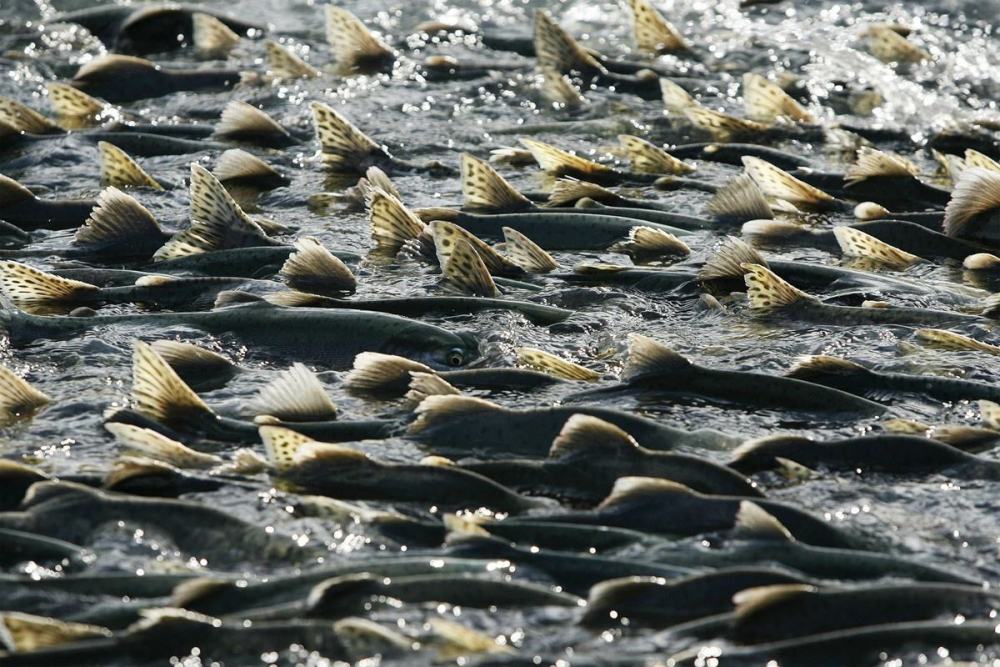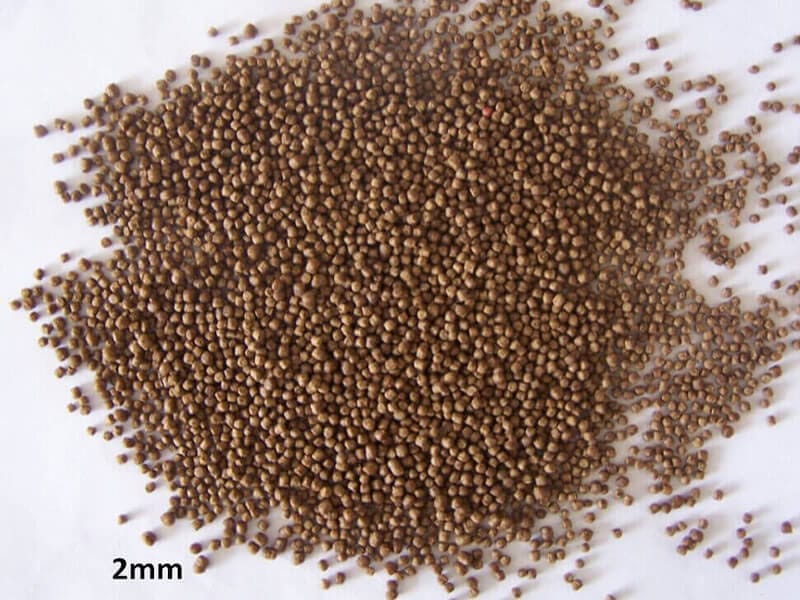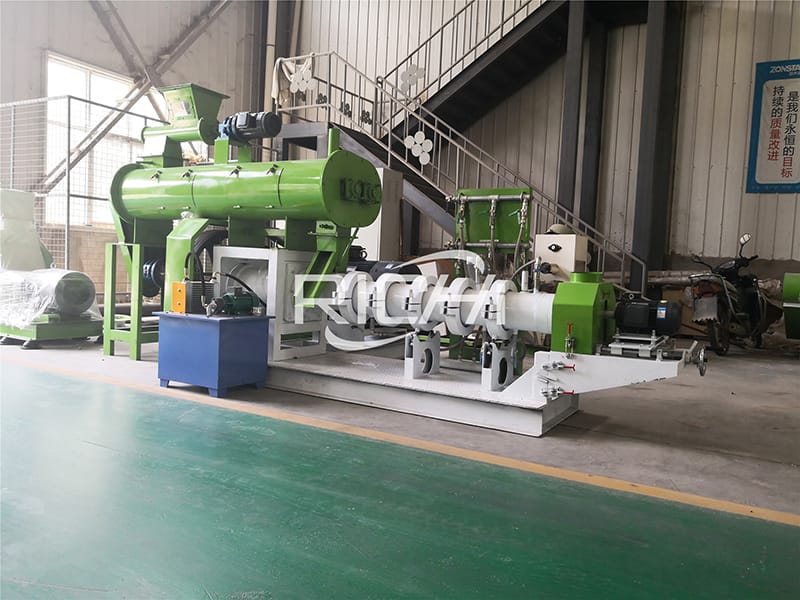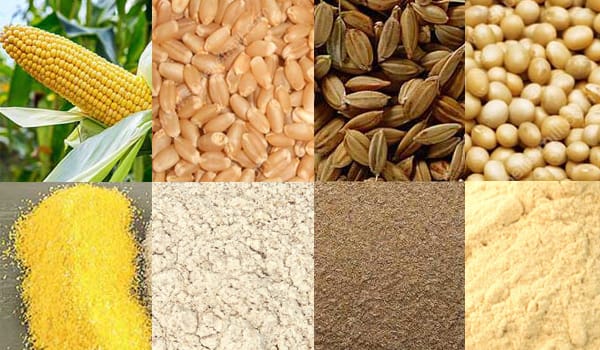Many customers have asked us such questions: "How can I produce fish feeds?", "how to prepare food for fish?", "How to make feed for fish","How to manufacture fish feed" . These customers all want to configure their own feed. Today we will provide you with some fish feed formulas and precautions for self-prepared fish feed.

1. Taking the self-made feed of Chinese breeding industry as an example
In 2019, China's aquaculture industry feed consumption was about 350 million tons, of which 210 million tons of commercial compound feed, accounting for 60%, and the remaining 40% were prepared by the farmers themselves. It can be seen that the proportion of the farmers' self-prepared feed It is also quite large, but the quality effect and feed safety are not completely certain. Therefore, on June 16, 2020, the Ministry of Agriculture and Rural Affairs of China issued Announcement No. 307, clarifying the nine bottom-line regulations for farmers' self-preparation of feed, which will be implemented on August 1, 2020. After the regulations are formally implemented, the ingredients produced by farmers will be more clearly followed, consistent with commercial feed in terms of prohibition and restriction requirements, which will be more conducive to maintaining the order of feed production and use and ensuring the quality and safety of aquaculture products. The regulations mainly set clear requirements for the use of raw materials, additives and veterinary drugs when farmers produce ingredients. Higher requirements are put forward for farmers to prepare feeds by themselves in order to reduce feeding costs. Of course, they also encourage farmers to have a new understanding of self-proportioning and have a more mature grasp of self-proportioning knowledge.
2. Reasons for the rise of self-prepared feed
In today's aquaculture industry, feed prices seem to have a regular and continuous increase every year. At the end of each year, you will see how much output value and annual profit have increased in the "annual report" of a certain feed company. Complacent! However, the selling price of farmed fish continues to be low or rarely increases, and the profits and losses of farming have always been around. On the one hand, the annual dividends of the feed companies are skyrocketing, and on the other hand, the farmers are afraid of losing money. Perhaps the profit of the animal feed manufacturers comes from the hard work of the farmers, which makes many farmers feel unwilling and complain about the profit margins of the feed manufacturers. "Self-ingredient breeding" came into being.
Advocating self-prepared feed to raise fish is of course beneficial to the economic benefits of aquaculture, and it is feasible in the current sluggish market. However, if you simply calculate the price difference or do not have a good understanding of feed production and fish nutrition needs, you may also lose more than you gain. It is laborious and troublesome, and the cost may come down, but the growth of the fish or the benefits of breeding may not be good. So, you must be careful! Because animal nutrition is a big major and very knowledgeable, it is not as simple as many people think.

3. The difference between self-made feed and feed processed by fish feed mill line
-
Raw materials for fish feed production
- At present, most of the raw materials or premixes needed for self-mixing are supplied by ordinary distributors. These distributors lack knowledge of raw materials and do not have some necessary testing equipment. Therefore, the quality of raw materials Control is often poorly done. For example, most farmers cannot accurately grasp the quality of fishmeal in raw materials, and it is easy to buy inferior or counterfeit fishmeal, which affects the quality of self-made ingredients. Most of the formal feed manufacturers have separate laboratories, which can not only control the raw materials well, but also control the products that leave the factory, which ensures the quality and stability of the feed to a certain extent. Sex.
-
Fish Feed Production Formula
- The design of fish feed making formula is a work with high technical requirements, and it is by no means a matter of "mixing" several raw materials casually. Therefore, feed manufacturers have professional formulators who can According to the different needs of the farmers or the different breeding species and specifications, reasonable different formulas are designed. Regular feed manufacturers not only have specialized formulars, but they also have strict controls on formula management. There is no random adjustment, thus ensuring the scientificity, rationality and seriousness of formulas.
- Because the self-feeding method of breeding started late, and everyone lacks the technical knowledge of aquatic feed formulation, they can only learn by themselves. Sometimes the feed is mixed based on feelings, or when the raw materials are temporarily lacking. , Adjust the composition of the formula at any time, increase the amount of some raw materials, and reduce the amount of other raw materials, which is very willful and arbitrary. Therefore, compared with large-scale feed factories, the self-mixed feed formula lacks scientificity and rationality.
-
Fish feed processing
- The self-prepared feed has an inherent shortcoming that the equipment is relatively simple and does not have the superior production conditions of a fish feed making plant factory, so there are many shortcomings in the processing of feed. First of all, farmers who make self-prepared feed are rarely equipped with fine fish feed hammer mill crushers and fish feed mixers or high-precision equipment, and the fineness and mixing uniformity of raw materials are mostly not as good as regular feed manufacturers. Secondly, the self-prepared feed adopts some small or eliminated feeder machines, and most of them have no steam conditioning system at all. The produced feed has not undergone conditioning, maturation, spraying and other processes. The rate is not guaranteed.
- The fish feed peocessing equipment of the regular fish feed mill factory is sophisticated, and the uniformity and fineness of the feed can generally meet the production standards. This is also an important difference from self-mixing. The production process of self-prepared feed needs to be improved, especially in some small fish feed processing plants. The processed feed often has problems such as uneven mixing of raw materials, high feed powdering rate, and easy loss after entering water.
- Click to visit Details of commercial fish feed line processing methods:https: //www.cn-pellet.com/solution/aquafeed-production-line/
-

4. Breeding benefits and feed coefficient
The key to the efficiency of breeding lies in the level of feed (bait) feed coefficient. The feed (bait) feed coefficient means that 1 catty of feed can grow multiple fish. This problem is mostly ignored. Usually, everyone is most concerned about the feed. For 1 catty of money, we are indifferent to the need to eat a lot of feed for the fish that increases the fish by 1 catty. Some people don't even understand it, and some people don't even know it.
In other words, if the self-mixing process does not meet the standard, although the cost has come down, the feed coefficient often rises; sometimes the manufacturer's feed cost is a little higher, but because the process is mature, the feed coefficient may be fed (bait) It's much lower. This is a choice before the breeders.
5. The main problems and requirements that should be paid attention to when making the ingredients
-
Pay attention to the fish feed production raw materials
- High-quality fish feed ingredients are a prerequisite for the preparation of high-quality feeds. Therefore, when self-prepared feeds are made, the raw materials must be checked and not too greedy for cheap. As the saying goes, "you get what you pay for," it makes sense. Products with good quality raw materials are often high in price, and low-priced raw materials are often of poor quality. When choosing the material, you can't just look at how much it costs, but also its nutritional guarantee value. If necessary, you can do a feeding experiment.
- Choose fish feed making raw materials, and if conditions permit, the more types of raw materials, the better, so as to ensure that the essential amino acids in the feed are as balanced as possible, and to meet the fish's needs for various essential amino acids to the maximum. It is not a simple matter to use only 3 or 5 kinds of raw materials and the target is only for the "protein ratio". In addition, moldy and deteriorated raw materials must not be used. Moldy raw materials contain a lot of bacteria and toxins. Easy to cause fish diseases.
-
Pay attention to maintaining the stability of formula and feed
- Fish feed formulas are generally designed according to common breeding models, which are scientific and reasonable, and cannot be changed at will during the ingredient process. For example, the amount of soybean meal cannot be increased or decreased arbitrarily, and rapeseed meal or cotton meal should not be used instead of soybean meal, otherwise it will cause excessive or insufficient protein content and high anti-nutritional factors in the feed, which will affect the growth and development of fish. Reduced economic benefits. If adjusted at will, it will lead to changes in the nutritional composition and palatability of the feed, and ultimately affect the growth and development of fish.
- Although fish feed processing raw materials such as cotton meal and rapeseed meal (oil dry) are cheap and have high protein content, they contain anti-nutritional factors such as gossypol and glucosinolate respectively, and excessive use will affect fish growth. Therefore, the amount should be limited, generally not more than 10%. The selection of raw materials must adhere to the principles of high quality and low price, stable supply and convenient transportation.
-
Pay attention to the uniformity of mixing
- At present, most farmers may use manual mixing when preparing feed. The uniformity of manual mixing is absolutely not up to the requirements. Even if it is mechanical mixing, the mixing intensity and time will not meet the requirements. This will also seriously affect the use effect of self-mixing. The coefficient of variation of feed mixing uniformity is usually not more than 10%. It is better to buy a mixer if conditions permit. The feed must be mixed well before use, and the breeding effect will be achieved.
-

6. Design a reasonable fish feed formula
Before designing the fish feed production formula, it is necessary to clarify the type and growth stage of the farmed fish in order to determine the level of nutrients such as protein and energy in the feed. It is necessary to meet the needs of protein for fish growth, and to make the ratio of energy to protein moderate. Both too high and too low energy-to-protein ratios are not conducive to fish growth.
When designing the formula, the relationship between feed nutrition and capacity should also be considered. It is necessary to ensure that the fish can take in sufficient nutrients and to make it feel full. Generally speaking, the price of protein feed is higher than that of energy feed. You must not try to increase the proportion of energy feed and reduce the proportion of protein feed. Doing so will increase the cost of feed virtually.
7. Control of fish feed processing technology
The technological process of self-prepared feed generally includes crushing, mixing, pelletizing and other processes. Where conditions permit, it also includes conditioning before pelleting by fish feed pelletizer machine. It is not good to pulverize the particle size to be too coarse or too fine. Generally, the raw materials of the compound feed for fish should pass through a 40-mesh sieve, and the material above the 60-mesh sieve should not exceed 20%. Because of the high protein content of fish feed, the feed temperature needs to be above 85°C. The particle size of pellet feed should be determined by the width of the fish's rip, and the particle size of the feed should be less than 1/2 of the rip width.
8. Advantages of self-prepared fish feed
-
Local resources can be fully utilized and fish feed costs can be reduced
- The self-preparation of raw materials reduces all aspects of feed in circulation, which can effectively reduce the cost of feed. When making self-prepared feeds, you can adapt to the time, local conditions, and locally source materials, make full use of self-produced feeds or local feeds with high nutrient content, low prices, and guaranteed sources, so as to save freight and labor expenses as much as possible, and reduce feed costs. For example, self-produced wheat, rice, rape, etc., to a greater extent reduce feed costs.
-
Disease prevention drugs can be added in time to control the occurrence of fish diseases
- Since most of the full-price feeds for farmed fish are in pellets or floats, it is inconvenient to add some additives or disease prevention drugs during use. When self-prepared feed, according to the needs of farmed fish, various feed additives and disease prevention drugs allowed by the policy can be added in time to further improve feed quality, increase feed conversion rate, and strengthen the prevention and control of fish diseases.
-
It is helpful to design a suitable feed formula according to the stocking mode
- Different regions and different farmers have different stocking patterns, and the required feed nutrition levels are also very different. Most manufacturers produce full-price feeds that design feed formulas based on the nutritional requirements of the main fish. , Basically unchanged. Using self-prepared feed can comprehensively consider the stocking ratio and nutritional requirements of the main fish and supporting fish according to the breeding mode and the stocking situation of different species of fish, and flexibly design a suitable feed formula to meet the nutrition of the fish. demand. The raw materials in the feed can be flexibly deployed, making it easier to meet the needs of their own breeding.
-
It is beneficial to adjust the feed formula in time according to the growth of fish
- With the growth of farmed fish, their nutritional requirements are also changing. Therefore, the nutritional level of feed is also required to be adjusted to a certain extent. Only in this way can it not only meet the nutritional needs of fish in various growth stages, It can effectively reduce feed costs. If you feed the manufacturer's feed, you will be more passive and cannot adjust the formula according to the growth of the fish in time. When preparing the feed, you can adjust the formula in time according to the growth of the fish and the climate change, appropriately reduce the nutritional level, and reduce unnecessary waste.
-
Special granulation conditions are conducive to the addition of various enzyme preparations
- Enzyme preparations have been used in livestock and poultry feeds for many years. Since various fish feeds have to undergo conditioning and maturation processes during the processing process, enzyme preparations are a type of active protein, and the activity is easily affected in the process. To damage, thereby limiting its use in fish feed. However, self-prepared feed mostly uses small-scale feed pelleting machinery, lack of conditioning and maturation technology during processing, and no high temperature and high heat conditions in the pelleting process, which not only avoids the loss of some heat-labile nutrients in the feed, but also provides It is possible to add heat-labile enzyme preparations and other heat-labile feed additives. Enzyme preparations can improve the utilization rate of feed to a certain extent, reduce the feed coefficient, reduce environmental pollution, and promote the growth of farmed fish.

9. Some fish feed making formula for you
-
Carp feed formula
- 43% bran, 30% fish meal, 15% soybean cake, 10% barley, additive 2%, feed coefficient 2. The bait factor is 2.
- Soy cake 50%, fish meal 15%, bran 15%, rice bran 15%, vitamin 1%, inorganic salt 1%, antibiotic scraps 1%, binder 2%, feed coefficient 2.70.
- 45% of bran, 40% of bean cake, 10% of barley, 5% of fish meal, add appropriate amount of multivitamin, inorganic salt, lysine, and methionine, and the feed coefficient is 2.
-
Grass carp feed formula
- 40% rice bran, 38% bran, 10% soybean cake, 10% fish meal, 2% yeast powder. The feed factor is 1.90. If you add green fodder, the feed factor is 2.20.
- 80% rice straw powder, 10% bean cake, 10% rice bran, feed coefficient 4.90, plus green feed, the coefficient is 13.
- Corn meal 70%, fish meal 10%, soybean meal meal 15%, bran 5%, the additives and binders added according to the total basic diet are: sweet potato flour 12%, salt 0.50%, auxin 2 %, calcium hydrogen phosphate 2%, feed coefficient 4.80.
- 80% of sweet potato vine powder, 15% of soybean meal, and 5% of bran. The additives and binders added according to the total basic diet are: sweet potato flour 12%, salt 0.50%, auxin 2%, phosphoric acid Hydrogen calcium is 2%, and the feed coefficient is 4.5.
-
Tilapia feed formula
- 45% of rice bran, 35% of bean cake, 10% of silkworm pupa meal, 8% of secondary meal, 1.50% of bone meal, 0.50% of salt, and feed coefficient of 2.27.
- 35% bean cake, 30% bran, 15% fish meal, 8.50% barley noodles, 5% corn noodles, 5% locust leaf powder, 1% bone meal, 0.50% salt.
-
Herring feed formula
- 40% rice straw meal, 30% silkworm pupa meal, 10% rapeseed meal, 20% barley meal, and a feed coefficient of 3.
- 40% green dry grass powder, 30% cottonseed meal powder, 10% soybean meal powder, 5% rapeseed meal powder, 5% silkworm pupa meal, 5% fish meal, 5% barley meal, and a feed coefficient of 3.
- Bean cake 47.5%, fish meal 35%, yeast 1%, inorganic salt, etc. 16.5%, the feed coefficient is 2.26.
To sum up, if you have a systematic knowledge of breeding, familiar with the knowledge of animal nutrition requirements, sufficient personnel and sufficient energy, you can completely prepare your own feed for aquaculture, which will help promote product quality and increase economic Benefits are of great significance. If you don't have the above conditions, you just blindly seek to reduce the cost of breeding, and simply put together a few raw materials in a hasty way, and you may not be able to achieve the final breeding effect. In a certain period of time in the future, the popularization of self-prepared breeding may be a big trend, and people need to work harder to study. Therefore, as far as the current view is, self-prepared feed has advantages but also disadvantages. It is feasible but not necessarily effective. Please be cautious!


